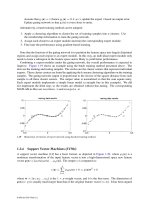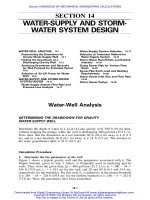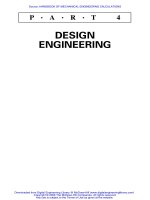Tài liệu Handbook of SPECIALTY ELASTOMERS pptx
Bạn đang xem bản rút gọn của tài liệu. Xem và tải ngay bản đầy đủ của tài liệu tại đây (6.86 MB, 572 trang )
Handbook of
SPECIALTY
ELASTOMERS
Robert C. Klingender/Handbook of Specialty Elastomers DK4127_C000 Final Proof page i 23.10.2007 7:54pm Compositor Name: TSuresh
Robert C. Klingender/Handbook of Specialty Elastomers DK4127_C000 Final Proof page ii 23.10.2007 7:54pm Compositor Name: TSuresh
CRC Press is an imprint of the
Taylor & Francis Group, an informa business
Boca Raton London New York
Handbook of
SPECIALTY
ELASTOMERS
Edited by
Robert C. Klingender
Robert C. Klingender/Handbook of Specialty Elastomers DK4127_C000 Final Proof page iii 23.10.2007 7:54pm Compositor Name: TSuresh
CRC Press
Taylor & Francis Group
6000 Broken Sound Parkway NW, Suite 300
Boca Raton, FL 33487-2742
© 2008 by Taylor & Francis Group, LLC
CRC Press is an imprint of Taylor & Francis Group, an Informa business
No claim to original U.S. Government works
Printed in the United States of America on acid-free paper
10 9 8 7 6 5 4 3 2 1
International Standard Book Number-13: 978-1-57444-676-0 (Hardcover)
This book contains information obtained from authentic and highly regarded sources. Reprinted
material is quoted with permission, and sources are indicated. A wide variety of references are
listed. Reasonable efforts have been made to publish reliable data and information, but the author
and the publisher cannot assume responsibility for the validity of all materials or for the conse-
quences of their use.
No part of this book may be reprinted, reproduced, transmitted, or utilized in any form by any
electronic, mechanical, or other means, now known or hereafter invented, including photocopying,
microfilming, and recording, or in any information storage or retrieval system, without written
permission from the publishers.
For permission to photocopy or use material electronically from this work, please access www.
copyright.com ( or contact the Copyright Clearance Center, Inc. (CCC)
222 Rosewood Drive, Danvers, MA 01923, 978-750-8400. CCC is a not-for-profit organization that
provides licenses and registration for a variety of users. For organizations that have been granted a
photocopy license by the CCC, a separate system of payment has been arranged.
Trademark Notice: Product or corporate names may be trademarks or registered trademarks, and
are used only for identification and explanation without intent to infringe.
Library of Congress Cataloging-in-Publication Data
Klingender, Robert C.
Handbook of specialty elastomers / Robert C. Klingender.
p. cm.
Includes bibliographical references and index.
ISBN 978-1-57444-676-0 (alk. paper)
1. Elastomers Handbooks, manuals, etc. I. Title.
TS1925.K46 2007
620.1’94 dc22 2007020182
Visit the Taylor & Francis Web site at
and the CRC Press Web site at
Robert C. Klingender/Handbook of Specialty Elastomers DK4127_C000 Final Proof page iv 23.10.2007 7:54pm Compositor Name: TSuresh
Contents
Preface vii
Editor ix
Contributors xi
Chapter 1 Polychloroprene Rubber 1
Rudiger Musch and Hans Magg
Chapter 2 Acrylonitrile Butadiene Rubber 39
Robert C. Klingender
Chapter 3 Hydrogenated Nitrile Rubber 93
Robert W. Keller
Chapter 4 Fluoroelastomers, FKM, and FEPM 133
Pascal Ferrandez
Chapter 5 Polyacrylate Elastomers—Properties and Applications 155
Robert C. Klingender
Chapter 6 Ethylene=Acrylic (AEM) Elastomer Formulation Design 193
Lawrence C. Muschiatti, Yun-Tai Wu, Edward McBride,
and Klaus Kammerer
Chapter 7 Polyepichlorohydrin Elastomer 245
Robert C. Klingender
Chapter 8 Compounding with Chlorinated Polyethylene 289
Ray Laakso
Chapter 9 Chlorosulfonated Polyethylene and Alkylated
Chlorosulfonated Polyethylene 301
Robert C. Klingender
Robert C. Klingender/Handbook of Specialty Elastomers DK4127_C000 Final Proof page v 23.10.2007 7:54pm Compositor Name: TSuresh
v
Chapter 10 Ethylene Vinyl Acetate Elastomers (EVM)
(ASTM Designation AEM) 343
Hermann Meisenheimer and Andrea Zens
Chapter 11 Polysulfide Elastomers 369
Stephen K. Flanders and Robert C. Klingender
Chapter 12 Plasticizers, Process Oils, Vulcanized Vegetable Oils 387
Peter C. Rand
Chapter 13 Vulcanization Agents for Specialty Elastomers 409
Robert F. Ohm
Chapter 14 Antioxidants for Specialty Elastomers 429
Russell A. Mazzeo
Chapter 15 Processing Aids for Specialty Elastomers 477
Jerry M. Sherritt
Chapter 16 Considerations in the Design of a Rubber Formulation 493
Robert C. Klingender
Part A: Oil Field Elastomer ic Products 495
Robert C. Klingender
Part B: Life Prediction 515
John Vicic
Part C: Compression, Transfer, and Injection Molding
of Specialty Elastomers 519
Robert W. Keller
Index 543
Robert C. Klingender/Handbook of Specialty Elastomers DK4127_C000 Final Proof page vi 23.10.2007 7:54pm Compositor Name: TSuresh
vi
Preface
The Handbook of Specialty Elastomers was conceived as a single refere nce source for
the rubber compounder with some experience in designing parts in the rubber
industry. The definition of specialty elastomers referenced in this publication is heat,
oil, fuel, and solvent-resistant polymers that include polychloroprene (CR), nitrile
rubber (NBR), hydrogenated nitrile rubber (HNBR), fluoroelastomer (FKM), poly-
acrylate (ACM), ethylene acrylic elastomer (AEM), polyepichlorohydrin (CO, ECO),
chlorinated polyethylene (CPE), chlorosulfonated polyethylene (CSM), ethylene
vinyl acetate (EAM), and thiokol (T).
In addition to the information on the specialty elastomers, chapters on the more
important ingredients used with them are included. These are plasticizers, vulcan-
ization agents, antioxidants and antiozonants, and process aids.
The final chapter, in three sections, provides one example of industry require-
ments for rubber parts, considerations to be made concerning the life expectancy of
elastomer compounds and processing factors to be taken into account in the molding
operation of a rubber factory.
It is the desire of the editor and contributing authors that this book provide a
comprehensive insight into the process of designing rubber formulations based on
specialty elastomers.
Robert C. Klingender/Handbook of Specialty Elastomers DK4127_C000 Final Proof page vii 23.10.2007 7:54pm Compositor Name: TSuresh
vii
Robert C. Klingender/Handbook of Specialty Elastomers DK4127_C000 Final Proof page viii 23.10.2007 7:54pm Compositor Name: TSuresh
Editor
Robert C. Klingender, a g raduate of the University of Toronto with a BASc
degree in chemical engineering, is retired after serving over 54 years in the rubber
industry. During that time he worked at Gutta Percha & Rubber Ltd., a mechanical
rubber goods manufacturer, as assistant chief chemist; Polysar Ltd., a synthetic rubber
producer, as technical service manager, technical service and sales district manager,
technical director of custom mixing; Goldsmith & Eggleton, a distributor for Nippon
Zeon, as vice president, technical products; and Zeon Chemicals, LLC, a synthetic
rubber producer in various technical sales and marketing functions. Bob’s career
focused on specialty elastomer applications in the mechanical and automotive
products industries.
Service to the rubber industry has been Klingender’s passion over the years,
having served in many capacities in the Rubber Division, ACS as well as the
Chicago, Wisconsin, Twin Cities and Northeast Ohio rubber groups.
In his various capacities, Klingender authored or coauthored over 15 technical
papers for the Rubber Division, ACS and various local rubber groups. In addition
he wrote some 25 technical bulletins and contributed a chapter on ‘‘Miscellaneous
Elastomers’’ to Rubber Technology, third edition, edited by Maurice Morton.
After retireme nt Robert has concentrated more on golf (with not too much
success), playing bridge, and gourmet cooking (a skilled rubber compounder can
also work well with food recipes).
Robert C. Klingender/Handbook of Specialty Elastomers DK4127_C000 Final Proof page ix 23.10.2007 7:54pm Compositor Name: TSuresh
ix
Robert C. Klingender/Handbook of Specialty Elastomers DK4127_C000 Final Proof page x 23.10.2007 7:54pm Compositor Name: TSuresh
Contributors
Pascal Ferrand ez
DuPont Performance Elastomers, LLC
Wilmington, Delaware, U.S.A.
Stephen K. Flanders (Deceased)
Morton International, Inc.
Woodstock, Illinois, U.S.A.
Klaus Kammerer
DuPont Performance Elastomers
International S.A.
Geneva, Switzerland
Robert W. Keller
Consultant
Lexington, Kentucky, U.S.A.
Robert C. Klingender
Specialty Elastomer Consulting
Arlington Heights, Illinois, U.S.A.
Ray Laakso
The Dow Chemical Company
Plaquemine, Lou siana, U.S.A.
Hans Magg
Bayer Corporat ion
Leverkusen, Germany
Russell A. Mazzeo
Mazzeo Enterprises
Waterbury, Con necticut, U.S.A.
Edward McBride
DuPont Packaging and Industrial
Polymers
Wilmington, Delaware, U.S.A.
Hermann Meisenheimer (Retired)
Bayer Corporation
Leverkusen, Germany
Rudiger Musch (Retired)
Bayer Corporation
Leverkusen, Germany
Lawrence C. Muschiatti
DuPont Performance Elastomers LLC
Wilmington, Delaware, U.S.A.
Robert F. Ohm
Lion Copolymer, LLC
Baton Rouge, Louisiana, U.S.A.
Peter C. Rand
Merrand International Corporation
Portsmouth, New Hampshire, U.S.A.
Jerry M. Sherritt (Retired)
Struktol Company
Barberton, Ohio, U.S.A.
John Vicic
Weatherford International, Inc.
Houston, Texas, U.S.A.
Yun-Tai Wu
DuPont Packaging and Industrial
Polymers
Wilmington, Delaware, U.S.A.
Andrea Zens
Bayer Corporation
Leverkusen, Germany
Robert C. Klingender/Handbook of Specialty Elastomers DK4127_C000 Final Proof page xi 23.10.2007 7:54pm Compositor Name: TSuresh
xi
Robert C. Klingender/Handbook of Specialty Elastomers DK4127_C000 Final Proof page xii 23.10.2007 7:54pm Compositor Name: TSuresh
1
Polychloroprene
Rubber
Rudiger Musch and Hans Magg
CONTENTS
1.1 Introduction 2
1.2 History, Polymerization, Structure, and Properties 2
1.2.1 History 2
1.2.2 Chloroprene Monomer Production 3
1.2.3 Polymerization and Copolymerization 3
1.2.4 Structure and Structural Variables 4
1.2.5 Structure and Properties 8
1.2.5.1 General Purpose Grades 8
1.2.5.2 Precrosslinked Grades 10
1.2.5.3 Sulfur-Modified Grades (S-Grades) 10
1.2.6 Commercially Available CR Rubbers 11
1.2.7 Compounding and Processing 14
1.2.7.1 Selection of Chloroprene Rubber Grades 14
1.2.7.2 Blends with Other Elastomers 14
1.2.7.3 Accelerators 15
1.2.7.4 Antioxidants, Antiozonants 17
1.2.7.5 Fillers 19
1.2.7.6 Plasticizers 21
1.2.7.7 Miscellaneous Compounding Ingredients 23
1.2.8 Processing 24
1.2.9 Properties and Applications 25
1.2.9.1 General 25
1.2.9.2 Physical Properties 25
1.2.9.3 Aging and Heat Resistance 26
1.2.9.4 Low-Temperature Flexibility 27
1.2.9.5 Flame Retardance 28
1.2.9.6 Resistance to Various Fluids 29
1.2.9.7 Resistance to Fungi and Bacteria 29
1.2.10 Applications 29
1.2.10.1 Hoses 29
1.2.10.2 Molded Goods 32
1.2.10.3 Belting 34
Robert C. Klingender/Handbook of Specialty Elastomers DK4127_C001 Final Proof page 1 22.10.2007 3:34pm Compositor Name: BMani
1
1.2.10.4 Extruded Profiles 34
1.2.10.5 Wire and Cable 34
1.2.10.6 Miscellaneous 36
References 36
1.1 INTRODUCTION
Polychloroprene was one of the first synthetic rubbers and has played an important
role in the development of the rubber industry as a whole, a fact that can be attributed
to its broad range of excellent characteristics.
In terms of consumption, polychloroprene has become a most important specialty
rubber for non-tire applications.
1.2 HISTORY, POLYMERIZATION, STRUCTURE, AND PROPERTIES
1.2.1 H
ISTORY
The polychloroprene story started in 1925,with the synthesis of the monomer byFather
Nieuwland [1]. The first successful polymerization under economically feasible con-
ditions was discovered in 1932 by Carothers, Collins, and coworkers using emulsion
polymerization techniques [2]. In the same year DuPont began marketing the polymer
first under the trade name Duprene and since 1938 as Neoprene. A wide range of
polychloroprene grades has since been developed to meet changing market demands
1940 A breakthrough in 1939 due to the development of a copolymer
with sulfur (Neoprene GN) featuring more desirable viscosity and
processing behavior
1950 Soluble, sulfur-free homo- and copolymers using mercaptans as
chain transfer agents (M-grades) offering improved heat resistance
were invented and, in the case of copolymers, these had reduced
tendency to crystallization (DuPont)
1960 Precrosslinked grades for improved processability, in particular
where reduced nerve and die swell is of prime concern (DuPont)
1970 Precrosslinked and soluble grades with improved physical and mech-
anical properties (DuPont)
sulfur-modified grades with higher dynamic load-bearing capacity
and better heat stability (DuPont)
1980 Commercially successful soluble homo- and copolymers using special
Xanthogen-disulfides as chain modifiers (XD-grades) with improved
processability and vulcanizate properties (Bayer AG=Distugil);
soluble copolymers with excellent performance under adverse climatic
conditions (extremely slow crystallization with a higher service tem-
perature) (Bayer AG=Denki)
1990 Newly developed M- and XD-grades combining low-temperature
flexibility, improved heat resistance, and dynamic properties as well
as low mold fouling (Bayer AG)
Robert C. Klingender/Handbook of Specialty Elastomers DK4127_C001 Final Proof page 2 22.10.2007 3:34pm Compositor Name: BMani
2 Handbook of Specialty Elastomers
Since 1933, when DuPont started up their first production plant, several other
companies have also joined the list of producers.
The current list of polychloroprene producers is shown in Table 1.1. Name plate
capacity for all plants worldwide, former Soviet Union included, is estimated to be
348,000 metric tons (2001). DuPont announced the closure of the Louisville, KY
plant by 2005, reducing worldwide capacity by 64,000 metric tons.
1.2.2 CHLOROPRENE MONOMER PRODUCTION
From the very beginning up to the 1960s, chloroprene was produced by the older
energy-intensive ‘‘acetylene process’’ using acetylene, derived from calcium car-
bide [3]. The acetylene process had the additional disadvantage of high invest-
ment costs because of the difficulty of controlling the conversion of acetylene
into chloroprene. The modern butadiene process, which is now used by nearly all
chloroprene producers, is based on the readily available butadiene [3].
Butadiene is converted into monomeric 2-chl orobutadiene-1,3(chloroprene) via
3,4-dichlorobutene-1 involving reactions that are safe and easy to control.
The essential steps in both processes are listed in Figure 1.1.
1.2.3 POLYMERIZATION AND COPOLYMERIZATION
In principle, it is possible to polymerize chloroprene by anionic-, cationic-, and Ziegler
Natta catalysis techniques [4] but because of the lack of useful properties, produc-
tion safety, and economical considerations, free radical emulsion polymerization is
TABLE 1.1
Production Facilities for Chloroprene Rubber (IISRP Worldwide Rubber
Statistic 2001)
Company Location Country
Capacity
a
(in Metric Tons)
DuPont Louisville USA 64,000
Pontchartrain USA 36,000
Bayer AG Dormagen Germany 65,000
Denki Kagaku Omi Japan 48,000
Enichem Champagnier France 40,000
Showa Kawasaki Japan 20,000
Tosoh Shinnayo Japan 30,000
Razinoimport Eravan Armenia 5,000
People’s Republic
of China
b
Chang Zhou People’s Republic
of China
5,000
b
Daiton 10,000
b
Qindau
a
Latex and adhesive grades included.
b
Estimated by editor.
Robert C. Klingender/Handbook of Specialty Elastomers DK4127_C001 Final Proof page 3 22.10.2007 3:34pm Compositor Name: BMani
Polychloroprene Rubber 3
exclusively used today. It is carried out on a commercial scale using both batch and
continuous processes.
A typical production flow diagram is shown in Figure 1.2.
Chloroprene in the form of an aqueous emulsion is converted with the aid
of radic al initiators into homopolymers or, in the presence of comonomers, into
copolymers [5].
Comonomers, which have been used with success, are those with chemical
structures similar to that of chloroprene, in particular
1. 2,3-Dichloro-butadiene to reduce the crystallization tendency, that is, the
stiffness of the chain.
2. Acrylic or methacrylic acid esters of oligo functional alcohols to produce
the desired precrosslinked gel polymers.
3. Unsaturated acids, for example, methacrylic acid, to produce carboxylated
polymers.
4. Elemental sulfur to produce polymer chains with sulfur segments in the
backbone, facilitating peptization.
1.2.4 STRUCTURE AND STRUCTURAL VARIABLES
Polychloroprene is highly regular in structure and consists primarily of trans-units;
however, there are sufficient cis-units to disturb the backbone symmetry and maintain
a rubbery state [6].
Therefore, the physical, chemical, and rheological properties of polychloroprene
are, to a large extent, dependent on the ability to change the molecular structure,
Acetylene process (1930)
Acetylene
CH
=
CH
CH
=
C
—
CH
=
CH
2
CH
2
=
C
—
CH
=
CH
2
CH
2
=
CH
—
CH
=
CH
2
+
Cl
2
=
CHCl
—
CH
2
Cl
CH
—
CH
2
Cl
CH
—
CH
2
—
Cl
cis- and
trans-1.4-
Dichlorobutene-2
−HCl
Iso-
merization
CH
=
CH
2
3,4-Dichloro-
butene-1
2-Chlorobutadiene-1,3 (b.p. 59.4°C)
Chloroprene
Advantage
Disadvantages
Advantages
Low cost feedstock
Safer and more economical process
Waste salt solution
Effluent problems
Disadvantages
Expensive feedstock
Process difficult to control
Reduced effluent problems
Cl
Monovinyl-acetylene
+HCl
Butadiene process (1960)
Butadiene
—
—
—
—
FIGURE 1.1 Acetylene and butadiene route to chloroprene.
Robert C. Klingender/Handbook of Specialty Elastomers DK4127_C001 Final Proof page 4 22.10.2007 3:34pm Compositor Name: BMani
4 Handbook of Specialty Elastomers
for example, the cis=trans ratio, long chain branching, and the amount of cross-
linking. Key roles in changing the molecular structure are played by
1. Polymerization conditions: polymerization temperature, monomer conver-
sion, polymerization process [7]
2. Polymerization aids: concentration and type of chain modifier, comonomers,
and emulsifier [8]
3. Conditions during finishing
Figure 1.3 compares the structural units of commercially available polychloro-
prene. In this polymer the 1,4 addition [1], in particular the 1,4-trans-addition (lb),
is dominant. In addition, small proportions of the 1,2-(II) and 3,4-(III) structures are
also present. These polymer structures are combined in sequential isomers derived
from head to tail (IV), head to head (VI), and tail to tail (V) addition [9].
In addition, the preparation of stereoregular polychloroprene by unusual poly-
merization conditions has demonstrated that the glass transition temperature and
the melting temperature of the polymer are inverse functions of polymerization
temperature [10,11] as seen in Figure 1.4).
Using standard polymerization conditions, crystallization is an inherent property
of all polychloroprene rubbers [12]. A homopolymer manufactured at 408C has a
trans-1,4-content of ca. 90%, a degree of crystallization of ca. 12%, and a crystall ine
melting temperature of ca. 45 8C. A reduction in the rate of crystallization is possible
Acid
Rotating cooling drum
Coagulation by freezing
Neutralization
Washing
Dryer
Chopping
machine
Roping machine
Dusting
machine
Latex-
concen-
tration
Peptization
Stripper
Polymerization
Water
Chloro-
prene
Regulator
Emulsifier
Purification
Unreacted monomer
Co-monomer
Recycled monomer
FIGURE 1.2 Flow diagram for the polymerization and isolation of polychloroprene.
Robert C. Klingender/Handbook of Specialty Elastomers DK4127_C001 Final Proof page 5 22.10.2007 3:34pm Compositor Name: BMani
Polychloroprene Rubber 5
by either decreasing trans-1,4-content or increasing non-1,4-conten t or by introdu-
cing comonomers. In practice, the latter is the easiest. The crystallinity in polychlo-
roprene makes processing difficult and the vulcanizate increases in hardness with
age. Therefore, polychloroprene polymers are normally produced at high polymeriz-
ation temperatures (308C–608C) or using additional comonomers interfering with
crystallization. Through such measures, the crystallizing tendency of polychloro-
prene in both the raw and vulcanized states is reduced.
The crystallization process is temperature dependent and has its maxi-
mum rate at À58CtoÀ108C. This effect is responsible for the hardening and
the reduction in elasticity of chloroprene rubber (CR) polymer compounds and
vulcanizates during storage at low temperatures. Crystallization is completely
reversible by heat or dynamic stress. In general, the raw polymers crystallize
10 times faster than vulcanized, plasticizer-free compounds (ISO 2475, ASTM D
3190-90).
Variations in microstructure are responsible for significant changes in polymer
properties. Figure 1.5 shows the main modifications of the polychloroprene chain
1. Structural isomers
Isomers of polychloroprene
2. Geometrical isomers
1,4-cis-addition (la)
3. Sequence isomers
(IV) Head-to-tail
(H/T)
(V) Tail-to-tail
(T/T)
(VI) Head-to-head
(H/H)
Free
radical
polymer
n H
2
C
=
C
—
CH
=
CH
2
Cl
(H
2
C
—
C
=
CH
—
CH
2
)−(CH
2
—
C
=
CH
—
CH
2
)
Cl
H
Cl
CH
2
H
2
C
C
=
C
1,4 Adduct (I)
~97%
1,2 Adduct (II)
~1,5%
3,4 Adduct (III)
~1,0%
(CH
2
—
C
=
CH
—
CH
2
)
x
~~
Cl
(CH
2
—
C
)
y
~~
Cl
CH
=
CH
2
∼∼
][
(CH
2
—
C
)
z
~ ~
H
Cl
—
C
=
CH
2
1,4-trans-addition (lb)
(CH
2
—
CH
=
C
—
CH
2
)−(CH
2
—
C
=
CH
—
CH
2
)
(H
2
C
—
C
=
CH
—
CH
2
)−(CH
2
—
CH
=
C
—
CH
2
)
~
~
~
~
~
~
{
—
—
—
—
—
—
H
Cl
CH
2
H
2
C
C
=
C
∼
∼
][
—
—
—
—
——
—
—
Cl
—
Cl
—
Cl
—
Cl
—
Cl
—
—
FIGURE 1.3 Structural units in the polychloroprene chain (typical commercial rubber grade)
crosslinking site.
Robert C. Klingender/Handbook of Specialty Elastomers DK4127_C001 Final Proof page 6 22.10.2007 3:34pm Compositor Name: BMani
6 Handbook of Specialty Elastomers
Polymerization temperature (°C)
T
g
(°C)
T
m
(°C)
−140
−50
−40
−30
−20
−10
0
10
20
30
40
50
60
70
80
90
−120−100 −80 −60 −40 −20 0 20 40 60 80 100 120
FIGURE 1.4 Glass transition temperature (T
g
) and melt temperature (T
m
) of polychloroprene
prepared at various temperatures.
(a) Linear, configuration uniform Sulfur-modified
R
R
R
R
RR
R
R
R
R
S
x
S
y
Precrosslinking
Crystallization resistant
Variations in MW and MW-distribution
Cl Cl Cl Cl
Cl Cl Cl
Cl Cl
x
x
(b) Linear, configuration nonuniform
(c) Branched, configuration nonuniform
(d) Linear, reactive end
g
roups
(e)
(f)
(g)
(h)
FIGURE 1.5 Modifications of the polychloroprene chain.
Robert C. Klingender/Handbook of Specialty Elastomers DK4127_C001 Final Proof page 7 22.10.2007 3:34pm Compositor Name: BMani
Polychloroprene Rubber 7
1. Increasing trans-content with decreasing polymerization temperature gives
increasing crystallization tendency (adhesive grades).
2. Increasing 1,2- and cis-1,4-additions with increasing polymerization tempera-
ture reduces crystallization and provides faster curing, necessary for rubber
grades (1,2-structures important for crosslinking with metal oxides).
3. Chain branchi ng with high polymerization temperature and high monomer
conversion results in reduced stability in polymer viscosity and processing
properties deteriorate.
4. Reactive end groups using XD-chain modifier provide reduced branching,
easy processing, and elastomers with more homogeneous networks, for
example, high tensile strength.
5. Polymer chains with sulf ur atoms in multiple sequences ranging from 2 to 8
show improved breakdown during mastication, outstanding tear resistance,
and dynamic behavior.
6. Specially induced precrosslinking yields sol=gel type blends yielding process-
ing and extrusion advantages with increasing gel content (10%–50%).
7. Reduced stereoregularity using comonomers leads to reduced crystallization
tendency and level, thus the so called ‘‘crystallization resistant grades.’’
8. Increasing molecular weight results in increasing the polymer viscosity and
tensile strength of vulcanizates.
9. Increasing molecular weight distribution gives improved processability and
reduced tensile strength.
1.2.5 STRUCTURE AND PROPERTIES
1.2.5.1 General Purpose Grades
1.2.5.1.1 Mercaptan-Modified (M-Grades)
This group contains non-precrosslinked, sulfur-free, soluble, homo- and copolymers
and is the most important in terms of the quantity used. It comprises the standard grades
with polymer viscosities of approximately 30–140 Mooney units (ML4 at 1008C) and
slight to medium crystallization types. These grades are also known as mercaptan
grades. Their property profiles tend to be influenced mainly by polymer viscosity.
Table 1.2 shows the changes in properties as a function of Mooney viscosity.
Grades with slight to very slight crysta llization shoul d be used in parts intended
for low-temperature service. The influence of crystallization tendency on polymer
and elastomer properties is listed in Table 1.3.
1.2.5.1.2 Xanthogen-Disulfide Grades
XD-grades are produced with a special modifier. Some of them are copoly merized
with other monomers to produce copolymers that have only a medium or slight
tendency to crystallization.
Processing behavior: They are generally less elastic (reduced ‘‘nerve’’) than
M-grades and are, therefore, more easily processed by calendering or extrusion.
Additionally, the ram pressure durin g mixing can be reduced and as a result the
compounds have greater scorch resistance.
Robert C. Klingender/Handbook of Specialty Elastomers DK4127_C001 Final Proof page 8 22.10.2007 3:34pm Compositor Name: BMani
8 Handbook of Specialty Elastomers
Vulcanizate properties: If M-grades are substituted with XD-grades in a given
recipe, vulcanizates with improved mechanical properties will result, that is, higher
tensile strength and tear.
Strength, rebound resilience, and resistance to dynamic stress are obtained. The
importance of these differences is emphasized in Figure 1.6.
In contrast to M-grades, the tensile strength of vulcanizates based on XD-grades
is essentially independent of the viscosity of the starting material within a broad
TABLE 1.2
Influence of Mooney Viscosi ty
Mooney Viscosity Influence
Low to high
Compatibility with fillers and oil
Filler dispersion in soft compounds
Dimensional stability and shape retention
‘‘Green strength’’ especially of heavily
loaded compounds
Air inclusion in soft molding compounds
Tensile strength
Modulus
Compression set
Mill banding
Mixing temperature
Energy consumption during mixing
Flow behavior
Die swell
Calendering properties
Note: Direction of arrow denotes improvement.
TABLE 1.3
Influence of Crystallization on Properties
Crystallization Influence
Slight to strong
‘‘Green strength’’
Cohesive strength
Setting rate (adhesives)
Tensile strength
Modulus
Tack and building tack
Retention of rubberlike properties at low
temperatures over long periods of time
Note: Direction of arrow denotes improvement.
Robert C. Klingender/Handbook of Specialty Elastomers DK4127_C001 Final Proof page 9 22.10.2007 3:34pm Compositor Name: BMani
Polychloroprene Rubber 9
viscosity range. This improved performance permits heavier filler and plasticizer
loadings, thereby reducing compound cost.
More recently developed M- and XD-grades show reduced nerve, significant
reduction in mold fouling, higher tensile strength, better aging characteristics,
significantly improved dynamic properties, and better low-temperature behavior.
1.2.5.2 Precrosslinked Grades
Precrosslinked grades have proven particularly suitable for extruded and calendered
goods and, in special cases, for injection molding. The precrosslinking that occurs
during the production of the polymer improves processability, because it reduces the
elasticity or ‘‘nerve’’ of the raw rubber and its compounds.
Typical characteristics are improved mill banding, low die swell, smooth sur-
faces, excellent dimensional stability, and in the case of XD-precrosslinked grades,
no decrease in tensile strength.
As the degree of precrosslinking rises, several proper ties of the compounds and
vulcanizates change as shown in Table 1.4.
1.2.5.3 Sulfur-Modified Grades (S-Grades)
Sulfur-modified grades are obtained by copolymerization of chloroprene with small
amounts of sulfur, followed by peptization of the resulting copolymer in the pre-
sence of tetra alkyl thiuram disulfide. Sulfur is built into the polymer chains in
short sequences.
Sulfur modification improves the breakdown of the rubber during mastication,
permitting the production of low-viscosity compounds with good building tack.
Only zinc oxide and magnesium oxide are needed for vulcanization. In many cases
XD-Grade
120
110
100
90
8070
6050
Raw material
Mooney viscosity (µ)
Tensile strength of vulcanizate (MPa)
4030
17.0
18.0
19.0
20.0
21.0
M-Grade
FIGURE 1.6 Tensile strength—Mooney viscosity relationship of M- and XD-modified
general purpose grades (Recipe ISO 2475).
Robert C. Klingender/Handbook of Specialty Elastomers DK4127_C001 Final Proof page 10 22.10.2007 3:34pm Compositor Name: BMani
10 Handbook of Specialty Elastomers
the vulcanizates have better tear resistance and adhesion to fabrics than those based
on general purpose grades.
Disadvantages: Polymers are less stable during storage and vulcanizates are less
resistant to aging.
Differences in the property profile of commercially available S-grades are caused
by different combinations of sulfur level, comonomers, soap system, polymerization
and peptization reactions, and staining or nonstaining stabilizers.
More recently developed grades give elastomers with a higher tear propagation
resistance, greater resistance to dynamic stress, and better aging behavior. They also
cause less mold fouling.
1.2.6 COMMERCIALLY AVAILABLE CR RUBBERS
Table 1.5 lists the most commonly used grades marketed in 2002 by the main
suppliers in the western hemisphere [13]. The available grades are divided into
three groups: general purpose grades (non-precrosslinked), precrosslinked grades,
and sulfur-modified grades.
TABLE 1.4
Relationship between Precrosslinking and Properties
Crosslinking Increases
Properties of raw compounds
Processing properties in general
(improvement is accompanied by loss of nerve)
Mill banding
Die swell
Extrusion rate
Dimensional stability and shape retention
Calender shrinkage
Smoothness of extrudates and calendered sheets
Dimensional stability of extrudates and calendered sheet
Air inclusion in soft compounds
Flow in injection molding
(improvement depends on compounding)
Building tack
Solubility in organic solvents
Vulcanizate properties
Modulus
Rebound resilience
Compression set (depends on type of compound)
Tensile strength
Elongation at break
Tear resistance
Note: Improvements in direction of arrow.
Robert C. Klingender/Handbook of Specialty Elastomers DK4127_C001 Final Proof page 11 22.10.2007 3:34pm Compositor Name: BMani
Polychloroprene Rubber 11
TABLE 1.5
Cross Reference of Polychloroprene Grades
DuPont
Bayer
Denki Kagaku Kogyo
Enichem
Showa DDE Mfg. TOSOH Corporation
Neoprene
Baypren
Denka Chloroprene
Butaclor
Neoprene
Skyprene
Grade ML 4 Grade ML 4 Grade
ML 4 Grade ML 4 Grade
ML 4 Grade ML 4
General Purpose Grades
Slow Crystallization Types
WRT-M1 38 110 45 S-40V
48 MC-10 45 WRT
46 B-5
49
WRT-M2 46 111 42
B-5A
45
112 42 S-40
=41 48 MC-20 46 WX-J
46 B-10
51
116
a
46
MC-122
a
43
B-11
49
126
a
70
B-10H 75
WD
110 130 105
Medium Crystallization Types
W
49 210 45 M-40
=
41 48 MC-30 46 W
46 B-30
49
WM-1
38 211 39 M-30
=31 38 MC-31 38 WM-1
37 B-31
40
216
a
46
MC-322 43
P-90
45
226
a
75
MC-323 59
M-70
70
WHV-100 97 230 100 M-1
00 100 MH-31 94 WHV-100
100 Y-31
100
WHV
115
M-120 120 MH-30 114 WHV
120 Y-30S 123
Robert C. Klingender/Handbook of Specialty Elastomers DK4127_C001 Final Proof page 12 22.10.2007 3:34pm Compositor Name: BMani
12 Handbook of Specialty Elastomers









